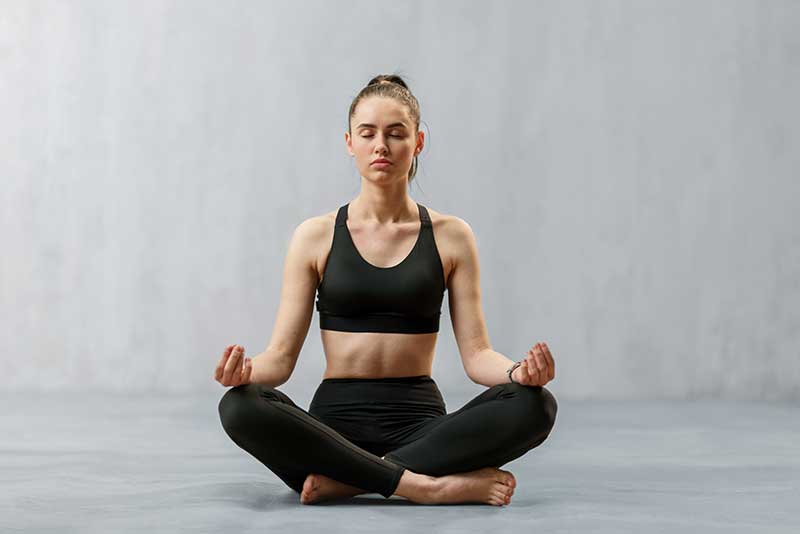“Pranayama: Where breathing exercises meet the world of yoga, creating a hilarious symphony of inhales, exhales, and occasional accidental snorts!
Hello dear yogis! We hope you are excelling in your pranayama practice. If you are someone who likes to compose melodious symphonies from your inhales and exhales, then we are here to help. In this blog, we have tried to cover 7 Types of Pranayama And Its Benefits to help you compose better and more beautiful pieces.
Types Of Pranayama: That You Must Know!
Pranayama offers a fascinating array of breathing techniques, each with its own unique style. Some techniques focus on taking slow, deep breaths that expand your belly or chest, giving you a sense of calm and grounding. Others involve controlling your exhales or inhales through specific nostrils, which might sound a bit strange at first, but it has its purpose! Some pranayama practices even incorporate breath retention, where you hold your breath either after inhaling or exhaling. There are techniques that involve rapid, forceful breaths or create soothing sounds during exhales. With these different approaches, you can experience relaxation, increased energy, improved focus, purifying energy channels, and even enhancing your respiratory function. So, let’s dive into different types of pranayama practices, their method and benefits. It’s a breathing adventure worth exploring! Here are the 7 types of pranayama practices that you must know.
1. Deep Belly Breathing (Diaphragmatic Breathing)

Method of doing Deep Belly Breathing Pranayama:
- Find a comfortable seated position.
- Place one hand on your belly and the other on your chest.
- Take a slow, deep breath in through your nose, allowing your belly to rise and expand.
- Exhale slowly through your nose, letting your belly fall inward.
- Continue this deep belly breathing pattern for several breaths, focusing on the rise and fall of your belly.
Benefit of Deep Belly Breathing Pranayama:
- Calms the nervous system: Deep belly breathing activates the parasympathetic nervous system, promoting a state of relaxation and reducing stress.
- Improves digestion: By engaging the diaphragm and massaging the internal organs, deep belly breathing enhances digestion and nutrient absorption.
- Enhances relaxation: The slow, deep breaths of diaphragmatic breathing induce a sense of calmness and tranquility.
2. Nadi Shodhana (Alternate Nostril Breathing)

Method of doing Nadi Shodhana:
- Sit comfortably and relax your body.
- Place your left hand on your left knee, palm facing upward.
- Bring your right hand up to your face and fold the index and middle fingers toward your palm.
- Close your right nostril with your right thumb and inhale deeply through your left nostril.
- Close your left nostril with your ring finger, release your thumb, and exhale through your right nostril.
- Inhale through your right nostril, close it with your thumb, release your ring finger, and exhale through your left nostril.
- Repeat this alternate nostril breathing pattern for several rounds, focusing on the breath flowing through each nostril.
Benefits of doing Nadi Shodhana:
- Balances energy channels: Nadi Shodhana helps to balance the flow of prana (energy) through the ida and pingala nadis, bringing harmony to the body and mind.
- Enhances mental clarity and focus: This technique clears the mind of mental fog, enhances concentration, and improves overall cognitive function.
- Reduces anxiety: The rhythmic pattern of alternate nostril breathing promotes a sense of calm, reduces stress, and helps to alleviate anxiety.
3. Kapalabhati (Skull Shining Breath)

Method of Kapalabhati pranayama:
- Sit in a comfortable position, with your spine erect.
- Take a deep breath in, filling your lungs with air.
- Exhale forcefully through your nose, contracting your abdominal muscles to push the breath out in short, rapid bursts.
- Allow the inhales to happen naturally as the exhales become rhythmic.
- Repeat this forceful exhale and passive inhale pattern for several rounds, gradually increasing the speed.
Benefits of Kapalabhati pranayama:
- Cleanses respiratory system: The forceful exhales in Kapalabhati expel stale air and toxins from the lungs, improving respiratory function and promoting lung health.
- Boosts lung capacity: By engaging the abdominal muscles and creating a strong exhale, Kapalabhati helps increase lung capacity and oxygen intake.
- Increases energy and vitality: The rapid breathing in Kapalabhati energizes the body, stimulates circulation, and invigorates the mind.
4. Ujjayi Breath (Victorious Breath)

Method of Ujjayi pranayama:
- Sit comfortably and relax your body.
- Inhale deeply through your nose, slightly constricting the back of your throat to create a gentle ocean-like sound.
- Exhale slowly through your nose, maintaining the constriction in your throat to produce the same sound.
- Continue this deep, audible breath, focusing on the sound and the sensation of the breath moving in and out.
Benefits of of Ujjayi pranayama:
- Promotes deep relaxation: The gentle constriction of the throat during Ujjayi breath creates a soothing sound, promoting a sense of calm and deep relaxation.
- Regulates body temperature: Ujjayi breath generates heat in the body, helping to regulate body temperature and maintain internal balance.
- Enhances concentration: The rhythmic, audible breath of Ujjayi helps to anchor the mind, improve focus, and enhance mental clarity.
5. Sheetali Pranayama (Cooling Breath)
Method of Sheetali Pranayama:
- Sit in a comfortable position, with your spine erect.
- Roll your tongue into a tube shape or purse your lips to create a small opening.
- Inhale slowly and deeply through your tongue or mouth.
- Close your mouth and exhale slowly through your nose.
- Repeat this cooling breath pattern for several rounds, focusing on the sensation of cool air entering and warm air leaving your body.
Benefits of Sheetali Pranayama:
- Cools the body and mind: Sheetali Pranayama has a cooling effect on the body, reduce body heat and calming the mind.
- Reduces anger and anxiety: By activating the body’s relaxation response, Sheetali Pranayama helps to alleviate anger, frustration, and anxiety.
- Improves digestion: The cooling breath supports healthy digestion and can provide relief from digestive discomfort.
6. Bhramari Pranayama (Bee Breath)
Method of Bhramari Pranayama:
- Find a quiet and peaceful place to sit comfortably.
- Close your eyes and take a few deep breaths to relax.
- Place your index fingers gently on your ears, covering the ear openings.
- Inhale deeply through your nose.
- Exhale slowly while making a low humming sound, like that of a bee.
- Allow the sound to resonate in your head and feel the vibrations throughout your body.
- Repeat this humming breath for several rounds, focusing on the sound and the sensation it creates.
Benefits of Bhramari Pranayama:
- Relieves stress, anxiety, and tension.
- Calms the mind and promotes mental clarity.
- Facilitates deep and restful sleep.
- Releases pent-up emotions and brings inner peace.
- Improves focus and concentration.
7. Anulom Vilom (Alternate Nostril Breathing with Retention)

Method of Anulom Vilom:
- Sit comfortably and relax your body.
- Place your left hand on your left knee, palm facing upward.
- Bring your right hand up to your face and fold the index and middle fingers toward your palm.
- Close your right nostril with your right thumb and inhale deeply through your left nostril.
- Close your left nostril with your ring finger, hold your breath for a few seconds, and release your thumb.
- Exhale through your right nostril, then inhale deeply through the right nostril.
- Close your right nostril with your thumb, hold your breath, and release your ring finger to exhale through your left nostril.
- Repeat this alternate nostril breathing pattern with breath retention for several rounds, focusing on the flow of breath and the pauses between inhalation and exhalation.
Benefits of Anulom Vilom:
- Balances energy flow in the body.
- Cleanses and purifies the nadis (energy channels).
- Improves respiratory function and lung capacity.
- Reduces anxiety and promotes relaxation.
- Enhances mental clarity and concentration.
Conclusion
Congratulations! You’ve embarked on a journey through the diverse world of different types of Pranayama. From deep belly breathing to humming like a bee, each technique offers its own set of benefits for your mind, body, and spirit. So, take a deep breath, explore these 7 types of Pranayama, and embrace the transformative power of conscious breathing. Get ready to experience a new level of well-being and vitality as you incorporate Pranayama into your daily practice.

Mr. Vijay Kumar Pandey is an eminent Yoga teacher with 15 years of experience. He excelled himself in Iyengar Yoga under the guidance of revered master BKS Iyengar Read More


